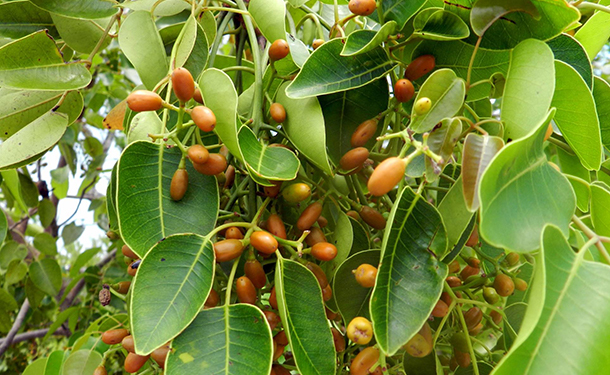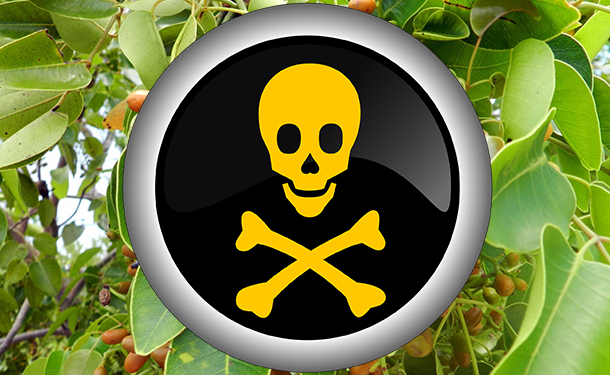Avoid severe rashes, itching, and blistering caused by contact with a poisonwood tree. Knowing how to identify and how this tree species adversely affects you will help you remain vigilant in avoiding its bark, sap, and foliage.

thetreecareguide.com gathered essential information and warnings about the poisonwood tree and what it can do to you.
Poisonwood Tree Information
Poisonwood grows as a large evergreen shrub or tree that reaches 25 to 35 feet tall in pinelands and sandy areas near saltwater. Learn to identify a poisonwood tree, as this tree species is abundant in the Florida Keys and multiple counties throughout southern Florida.
This tree species has a rounded form with a short trunk, arching limbs with drooping branches, and often a purplish-blackoily spot. The tree’s bark varies in color from reddish brown to gray and typically has oily patches of toxic sap on the surface. Each leaf comprises three to seven oval leaflets, which are glossy and dark green on the top and paler underneath. The fruit is ½ inch long, oval, and yellow to orange in color.
Note: While toxic to humans, poisonwood fruit is a crucial food source for the threatened white-crowned pigeon.
Metopium Toxiferum Toxicity
Metopium Toxiferum is related to poison oak, poison ivy, and poison sumac. The tree produces the same irritant, urushiol, which causes an itchy, blistering rash.
The oils from Metopium toxiferum cause dermatitis ranging in severity from a light red rash to intense skin blistering. Tea made from Metopium toxiferum leaves and twigs combined with bleach has been used to induce abortions but has also tended to kill the patient.
Note: Studies have found that Metopium Toxiferum produces a variety of allelopathic chemicals, which inhibit the growth of any nearby competitors.
What Does The Poisonwood Tree Do to You?
Urushiol is a highly potent irritant that can cause serious injuries. The substance is found in most parts of poisonwood trees, including the leaves, bark, and inner wood.
When you get urushiol on your skin, it causes allergic contact dermatitis. This affliction is a T cell-mediated immune response in which the body’s immune system recognizes it as foreign and vigorously reacts to the urushiol-derivative complexes with skin proteins.
Note: The smoke of burning Metopium toxiferum wood is highly irritating when inhaled. Even rainwater that drips from the branches and leaves may cause a severe rash.
How to Treat Metopium Toxiferum Poisoning
Applying a topical over-the-counter skin protectant, like zinc acetate, zinc carbonate, zinc oxide, or calamine, dry the oozing and irritation caused by urushiol oil. Protectants like baking soda or colloidal oatmeal can relieve minor irritation and itching.
In severe cases or if the rash is on the face or genitals, seek immediate professional medical attention.
Call 911 or go to a hospital emergency room if you develop a severe allergic reaction, like swelling or difficulty breathing, or have had a past severe reaction.
Urushiol ingestion (of any amount) can lead to severe, systemic reactions and should be treated as poisoning.
Get help from Poison Control immediately if you suspect Metopium Toxiferum poisoning. Free, expert help is available 24/7 from Poison Control Centers at:
(800) 222-1222 or Web Poison Control

What Is the Poisonwood Tree Used for
Black poisonwood (Metopium brownei) is well-known for being easy to work, hard, heavy, and durable. It often features rich dark red colors and attractive figuring. The species’ wood is primarily used to make interior products, like cabinets, furniture, and flooring, but is also used in other external applications, like vehicle trim and bridge construction.
What Is the Ecological Value of Poisonwood Trees
Toxic to humans, the poisonwood tree species plays a crucial role in nature, providing home and nurture for multiple butterfly and bird species. Butterflies use its flowers as a source of nectar (including the Bahamian and giant swallowtails, the Florida white butterfly, and the mangrove skipper). The tree’s small drupe fruit provides sustenance for white-crowned pigeons during their nesting season, and the Bahamian parrot also makes these drupes part of its diet.
Toxic Poisonwood Trees
In this article, you discovered essential species information, advisories, and warnings about the dangerous poisonwood tree and how to seek help when contact with this tree causes a reaction.
Knowing how to correctly identify and avoid the poisonwood tree will help you prevent severe skin rash, painful blisters, and other unpleasant side effects.
Ignoring the poisonwood tree’s extreme toxicity and inherent dangers can cause painful skin irritation and excruciating blisters immediately after contact.
Sources:
edis.ifas.ufl.edu/publication/EP220
ius.edu/environmental-health-safety/files/poisonous-plants.pdf
fda.gov/consumers/consumer-updates/outsmarting-poison-ivy-and-other-poisonous-plants
cdc.gov/niosh/topics/plants/exposure.html
nps.gov/ever/learn/nature/barkingupatree.htm
florida.plantatlas.usf.edu/plant.aspx?id=581
Photo credit: Florida Keys National Wildlife Refuges Complex